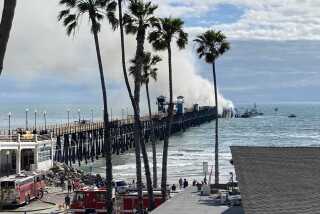Old chemicals still a danger to seals
More than a generation has passed since manufacturers in Southern California dumped large quantities of the pesticide DDT and the chemical PCB into the Los Angeles County sewer system, which spilled them onto the ocean floor off the Palos Verdes Peninsula.
But a Cal State Long Beach lecturer and a student have found that the toxic chemicals continue to exact a toll on the local marine environment, as shown by high concentrations present in marine mammals, including seals and sea lions.
Between the late 1940s and early 1970s, about 110 tons of DDT and 11 tons of PCB were dumped off the peninsula’s White Point, the Environmental Protection Agency estimates. The chemicals settled to the ocean floor and have spread over about 25 square miles.
The study analyzed the presence of toxic substances in blubber samples from 145 seals and sea lions that died at two facilities that treat sick and injured marine animals, the Fort MacArthur Marine Mammal Center in San Pedro and the Pacific Marine Mammal Center in Laguna Beach. The animals died between 1994 and 2006.
The new study found DDT, a once widely used agricultural pesticide now banned in the United States, in slightly lower concentrations in sea lions than was found in studies of marine mammals conducted in the early 1970s, according to the report published in the Marine Pollution Bulletin.
Adult male sea lions and seals had the highest concentrations because they had the highest fat content. But the chemicals were also present in pups, who absorbed them from their mothers’ milk.
Mary Blasius, a marine biology master’s student who conducted the research with lecturer Gwen Goodmanlowe, said the levels of contamination off the Los Angeles and Orange County coasts were 10 times higher for DDT and five times higher for PCB than in Northern California.
Blasius noted that more research needs to be done on how the toxicity levels are affecting the marine mammals. But she said the study points up possible danger to humans, whose diets include some of the same animals consumed by seals and sea lions.
“The animals that reside in the sediment are consuming these chemicals, and then fish consume those organisms,” Blasius said. “The higher you move up the food chain, the more you ingest.”
--
More to Read
Start your day right
Sign up for Essential California for news, features and recommendations from the L.A. Times and beyond in your inbox six days a week.
You may occasionally receive promotional content from the Los Angeles Times.






